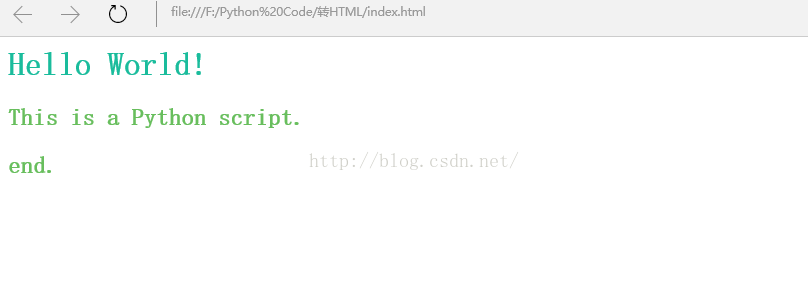用Python写一个文本转HTML的脚本
在 实验楼 上看的,自己看了一下感觉用处很大,代码也不难懂,特分享一下。
给定一个.txt文件,将其转换成HTML网页。
我们先来编写代码:
#!/usr/bin/python
# encoding: utf-8
#util.py
def lines(file):
"""
生成器,在文本最后加一空行
"""
for line in file: yield line
yield '\n'
def blocks(file):
"""
生成器,生成单独的文本块
"""
block = []
for line in lines(file):
if line.strip():
block.append(line)
elif block:
yield ''.join(block).strip()
block = []#!/usr/bin/python
# encoding: utf-8
#handlers.py
class Handler:
"""
处理程序父类
"""
def callback(self, prefix, name, *args):
method = getattr(self, prefix + name, None)
if callable(method): return method(*args)
def start(self, name):
self.callback('start_', name)
def end(self, name):
self.callback('end_', name)
def sub(self, name):
def substitution(match):
result = self.callback('sub_', name, match)
if result is None: result = match.group(0)
return result
return substitution
class HTMLRenderer(Handler):
"""
HTML 处理程序,给文本块加相应的 HTML 标记
"""
def start_document(self):
print ('ShiYanLou ')
def end_document(self):
print ('')
def start_paragraph(self):
print ('')
def end_paragraph(self):
print ('
')
def start_heading(self):
print ('')
def end_heading(self):
print ('
')
def start_list(self):
print ('')
def end_list(self):
print ('
')
def start_listitem(self):
print ('')
def end_listitem(self):
print (' ')
def start_title(self):
print ('')
def end_title(self):
print ('
')
def sub_emphasis(self, match):
return '%s' % match.group(1)
def sub_url(self, match):
return '%s' % (match.group(1), match.group(1))
def sub_mail(self, match):
return '%s' % (match.group(1), match.group(1))
def feed(self, data):
print (data)
#!/usr/bin/python
# encoding: utf-8
#rules.py
class Rule:
"""
规则父类
"""
def action(self, block, handler):
"""
加标记
"""
handler.start(self.type)
handler.feed(block)
handler.end(self.type)
return True
class HeadingRule(Rule):
"""
一号标题规则
"""
type = 'heading'
def condition(self, block):
"""
判断文本块是否符合规则
"""
return not '\n' in block and len(block) <= 70 and not block[-1] == ':'
class TitleRule(HeadingRule):
"""
二号标题规则
"""
type = 'title'
first = True
def condition(self, block):
if not self.first: return False
self.first = False
return HeadingRule.condition(self, block);
class ListItemRule(Rule):
"""
列表项规则
"""
type = 'listitem'
def condition(self, block):
return block[0] == '-'
def action(self, block, handler):
handler.start(self.type)
handler.feed(block[1:].strip())
handler.end(self.type)
return True
class ListRule(ListItemRule):
"""
列表规则
"""
type = 'list'
inside = False
def condition(self, block):
return True
def action(self, block, handler):
if not self.inside and ListItemRule.condition(self, block):
handler.start(self.type)
self.inside = True
elif self.inside and not ListItemRule.condition(self, block):
handler.end(self.type)
self.inside = False
return False
class ParagraphRule(Rule):
"""
段落规则
"""
type = 'paragraph'
def condition(self, block):
return True#!/usr/bin/python
# encoding: utf-8
#makeup.py
import sys, re
from handlers import *
from util import *
from rules import *
class Parser:
"""
解析器父类
"""
def __init__(self, handler):
self.handler = handler
self.rules = []
self.filters = []
def addRule(self, rule):
"""
添加规则
"""
self.rules.append(rule)
def addFilter(self, pattern, name):
"""
添加过滤器
"""
def filter(block, handler):
return re.sub(pattern, handler.sub(name), block)
self.filters.append(filter)
def parse(self, file):
"""
解析
"""
self.handler.start('document')
for block in blocks(file):
for filter in self.filters:
block = filter(block, self.handler)
for rule in self.rules:
if rule.condition(block):
last = rule.action(block, self.handler)
if last: break
self.handler.end('document')
class BasicTextParser(Parser):
"""
纯文本解析器
"""
def __init__(self, handler):
Parser.__init__(self, handler)
self.addRule(ListRule())
self.addRule(ListItemRule())
self.addRule(TitleRule())
self.addRule(HeadingRule())
self.addRule(ParagraphRule())
self.addFilter(r'\*(.+?)\*', 'emphasis')
self.addFilter(r'(http://[\.a-zA-Z/]+)', 'url')
self.addFilter(r'([\.a-zA-Z]+@[\.a-zA-Z]+[a-zA-Z]+)', 'mail')
"""
运行程序
"""
handler = HTMLRenderer()
parser = BasicTextParser(handler)
parser.parse(sys.stdin)
写完之后,让我们来测试一下。
看,大功告成
